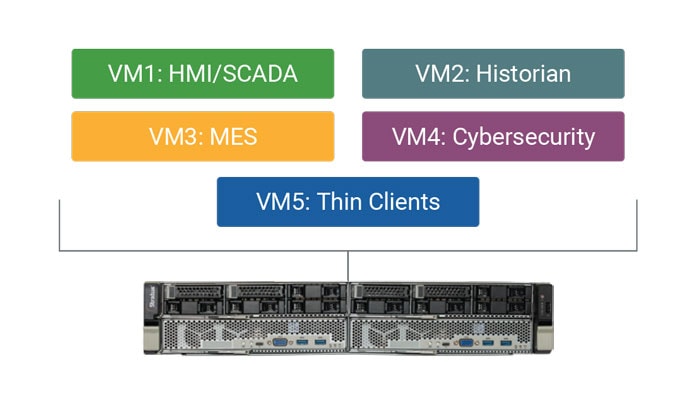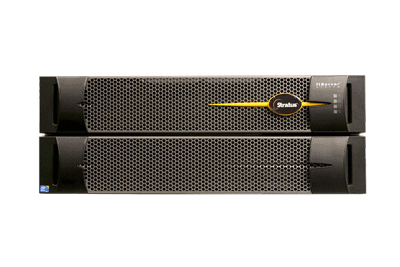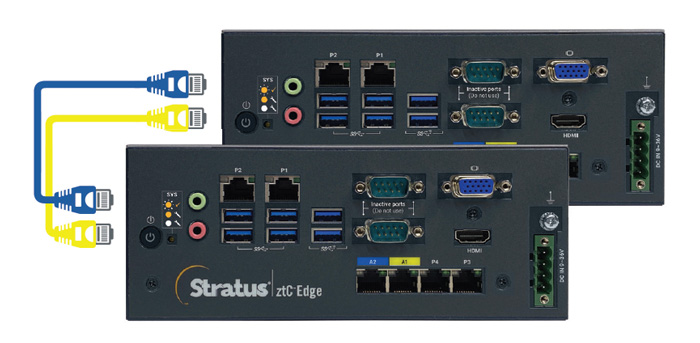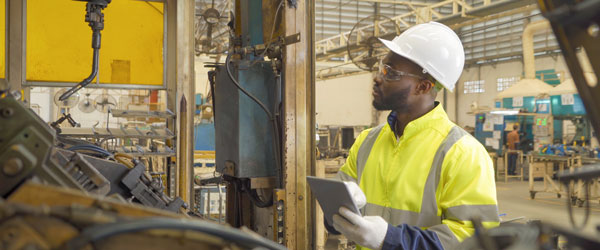Solution Brief
Virtualization with Stratus Zero-Touch Computing Platforms
Modernize and Future Proof Operations with Workload Consolidation Backed by Fault Tolerance
More than ever, information technology (IT) teams are partnering with manufacturing and facility management to modernize industrial automation systems and connect critical data to the enterprise. This is especially true as the operational technology (OT) environment becomes increasingly complex and teams pursue shared digital initiatives to increase efficiency, gain insights, and strengthen security.
Bringing virtualization to industrial automation is a practical solution that solves both IT and OT requirements; IT teams are well versed in virtualization to efficiently deploy software, minimize infrastructure, streamline architectures, and simplify management. By running the entire software stack on a single fault tolerant computing platform, OT teams can also meet their requirements for maximum reliability, data integrity, easy deployment of complex software, and serviceability.
Stratus zero-touch computing platforms support standard hypervisors and software – such as VMware vSphere and Microsoft Hyper-V – that run virtual machines (VMs). Additionally, they offer built-in virtualization specially engineered for deployment in OT environments. With up to 99.99999% uptime, Stratus platforms running multiple virtual machines enable OT and IT teams to consolidate their critical applications on a single platform and run them without downtime or data loss.
By doing so, organizations can dramatically simplify application deployment and management, modernize and future proof vital infrastructure, and reduce total cost of ownership (TCO) with full confidence.
Stratus zero-touch computing simplifies application management, consolidating workloads and reducing costs
OT teams often face challenges maintaining legacy systems and software, managing disparate infrastructure and “islands of automation” or bespoke implementations, and are pursuing projects to upgrade control architectures for safety and reliability. Virtualization presents a practical solution for IT and OT teams to employ as part of infrastructure modernization projects and provides a foundation to deploy and manage complex software and applications in the future.
Using Stratus zero-touch computing platforms backed by Stratus fault tolerance, IT and OT teams can confidently consolidate dozens of applications onto a single platform. Virtualization also provides IT teams with a familiar platform to have a “landing zone” in the OT space. A resulting software stack might include core IT and OT applications such as:

For the OT environment, this workload consolidation dramatically reduces the number of devices needed to operate, maintain, and support, thereby reducing footprint and rack space, as well as related cabling, wiring, and power.
On the IT front, workload consolidation provides streamlined management of OT assets and allows deployment of critical cybersecurity applications that are essential to fortify an organizations’ security posture, a shared IT and OT objective.
Virtualization with Stratus zero-touch computing platforms
Stratus zero-touch computing platforms are purpose-built to run fault tolerant computing in a range of environments, from the IT edge to the OT edge.
Stratus ztC Endurance™
Stratus ztC Endurance enables organizations to run critical applications without downtime or data loss using intelligent, predictive fault tolerance and 99.99999% uptime reliability. With built-in virtualization, teams can easily consolidate multiple servers and devices onto a single, fault tolerant platform, allowing them to run 12-40+ VMs, improve
performance, reduce total IT footprint and costs while ensuring application availability and uptime.


Stratus ftServer®
Stratus ftServer is a computing platform uniquely engineered to run mission-critical applications in the data center, control room, or an edge location without downtime or data loss. Using ftServer, organizations can rapidly modernize IT infrastructure to maximize reliability, simplify manageability, and increase efficiency with minimal risk. The platform offers the flexibility to consolidate workloads with the hypervisor of your choice and can run anywhere between 1-30 VMs depending on the use case.
Stratus ztC Edge™
Stratus ztC Edge is a secure, rugged, highly automated computing platform that enables the rapid and efficient delivery of reliable mission-critical applications in remote, understaffed locations at the edge of corporate networks. Built-in virtualization with an intuitive management console makes it easy for local OT teams and remote IT teams to set up, configure, import, and manage up to 4 VMs.

Why Stratus zero-touch computing?
Stratus zero-touch computing platforms are secure, highly automated, and easy to service, delivering redundant virtualized applications quickly and easily, improving productivity and reducing risk. They also have proactive predictive capabilities that resolve issues through continuous monitoring and self-healing mechanisms. With an intuitive management console, a Stratus zero-touch computing platform is easy for both local and remote staff to install and set up with flexibility and optionality. Stratus offers system support, system health add-ons, and managed support services to ensure health monitoring, keeping critical workloads running with minimal customer effort.
Stratus zero-touch computing offers IT and OT teams:
Simple: Simple to install, deploy, and manage across applications and infrastructure
Protected: Protects physical assets, data, security, and reputation—and reduces operational and financial risk
Autonomous: Operates autonomously with constant availability, minimizing unplanned downtime and enabling fully remote management
About Stratus
Stratus delivers simple, protected, and autonomous zero-touch Edge Computing platforms for leaders who are digitally transforming their business-critical operations in order to achieve continuous availability and predictable, peak performance with minimal risk.






